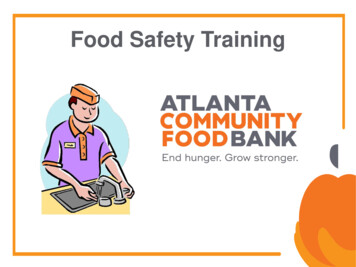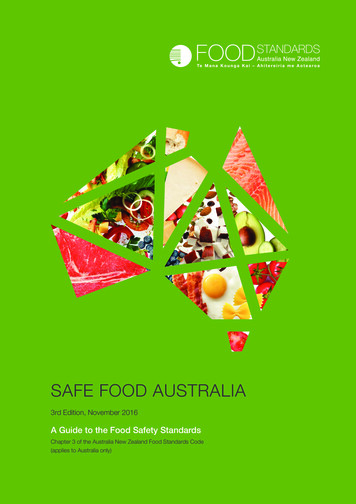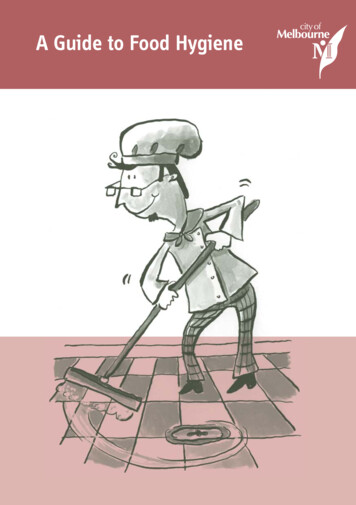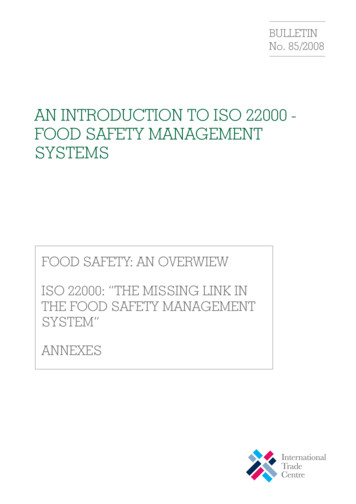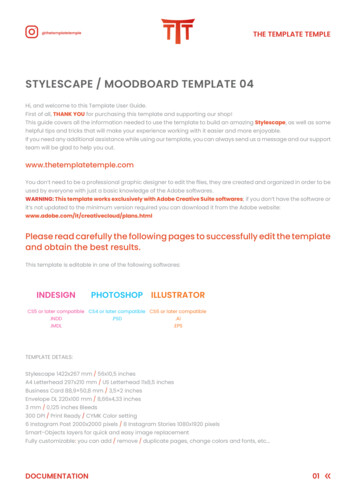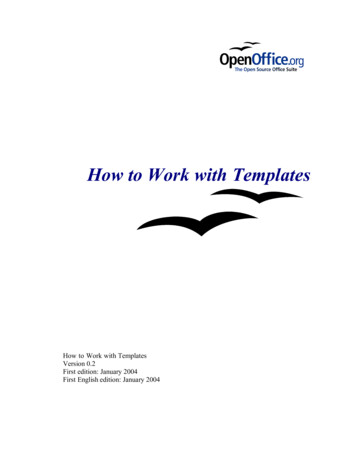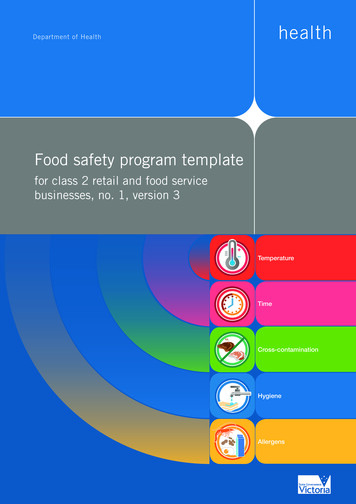
Transcription
Food safety program templatefor class 2 retail and food servicebusinesses, no. 1, version s
Food safety program templatefor class 2 retail and food servicebusinesses, no. 1, version 3
If you would like to receive this publication in an accessible format please phone 1300 364 352using the National Relay Service 13 36 77 if required, or email: foodsafety@health.vic.gov.auThis document is available as a PDF on the internet at: www.health.vic.gov.au/foodsafety Copyright, State of Victoria, Department of Health 2014This publication is copyright, no part may be reproduced by any processexcept in accordance with the provisions of the Copyright Act 1968.Unless indicated otherwise, this work is made available under the terms of the Creative Commons Attribution3.0 Australia licence. To view a copy of this licence, visit creativecommons.org/licenses/by/3.0/auIt is a condition of this Creative Commons Attribution 3.0 Licence that you must give credit to the originalauthor who is the State of Victoria.Authorised and published by the Victorian Government, 1 Treasury Place, Melbourne.ISBN 978-0-9924829-0-9 (Print)ISBN 978-0-9924829-1-6 (pdf)(1405008) June 2014Food safety program templatefor class 2 retail and food service businesses, no. 1, version 3
ContentsHow to use the food safety program template1Why do I need this template?2How do I prepare and use a food safety program?4How can food in my business cause illness?6How can I keep food safe in my business?8What practices must I use in my business?10Practices to keep food safe131Purchasing and receiving food142Storage173Thawing frozen food214Preparation235Cooking food266Cooling and freezing food307Reheating prepared food328Serving food and displaying food349Packaging and transporting food3810 Food vans, stalls, events and off-site catering41Support programs451Food allergens, intolerances and general information for customers462Cleaning and sanitising523Supervision of food handlers544Food handlers’ responsibilities575Thermometers and equipment606Pest control647Food recalls and waste disposal668Time control68GlossaryFood safety program templatefor class 2 retail and food service businesses, no. 1, version 371
How to use the food safety program templateWhy do I need this template?How do I prepare and use a food safety program?How can food become unsafe in my business?How can I keep food safe in my business?What practices must I use in my business?Food safety program templatefor class 2 retail and food service businesses, no. 1, version 31
How to use the food safety program templateWhy do I need this template?As a food business owner, you are legally required to sell safe food. The legislation governing the sale of safefood is the Food Act 1984, which incorporates the Australia and New Zealand Food Standards Code.A food safety program is a written plan that describes how you will manage food safety in your business.It is a legal requirement for class 2 food premises.Your food safety program documents how you will identify and control hazards in the production, preparationand handling of food as described in the Hazard Analysis and Critical Control Point (HACCP) system. Thisprogram also specifies the records that your business must maintain to demonstrate the implementation of theprogram and actions taken to keep food safe.The food safety program will help you to: identify when food can become unsafe take steps to avoid food becoming unsafe follow practices in your business to keep food safe use records to monitor food safety and to demonstrate that your business routinely follows these practices ensure staff have the knowledge and skills to handle food safely.As you work through this template you will create your own food safety program for your business.Using the program, following the advice in it, and keeping the required records will help to ensure that the foodyou sell is safe for your customers to eat. Before renewing your registration each year, council needs to beassured that you are complying with the law so that your business can continue to operate. Your food safetyprogram will show your council how you are complying with the law.UpdatesThis template is one of a number of food safety program templates registered with the Department of Health.Before using it, check with the department that the version you are reading is still current.Scope – who can use this template?This food safety program template is for the following food businesses. If you wish to use it, all of the followingmust apply to you:1. Your food business is a retail or food service business. This includes a premises at which you sell food tothe public or prepare food for sale that is ready for immediate consumption. This includes cafés, restaurants,bakeries or catering kitchens.2. Your registering council has classified the place that you are operating the business from as a class 2 foodpremises under the Food Act.3. This place might be: a building that you operate from regularly, such as a shop or café a building that you use occasionally, such as a hall or kitchen for hire a food van, vehicle or trailer (a mobile food premises) a portable stall, tent or marquee that you set up at different locations.2Food safety program templatefor class 2 retail and food service businesses, no. 1, version 3
part prepare food at a premises, such as a café, and reheat and serve that food at another premises, such asa portable stall, tent, marquee or van, or are a caterer who part prepares food at your main kitchen and serves it off-site at a variety of locations.To check whether your activity is class 2, contact your council for advice or go to www.health.vic.gov.au/foodsafety , look under Food business information and follow the links about classification.This template applies, as set out above, to for-profit businesses, and also to community groups that sell food.However, if you are a community group, and you sell food only from a – stall vehicle building (such as a hall or other location) that you use occasionally –you may prefer to use a shorter template developed especially for community groups. To access this go to www.health.vic.gov.au/foodsafety/home/community .This template must never be used for a food vending machine as it is not designed for this purpose. Go to www.health.vic.gov.au/foodsafety to find out what types of programs can be used for these machines.This template is especially suited to small or medium scale activities. If you are not sure whether this templateis suitable for your business (for example, large scale commercial catering, or complex manufacturing) or yourfood handling activities are different to those outlined in this template, you might need to consider getting anindependent food safety program tailored for your business. If you do, the program will need to be auditedby an approved auditor. Alternatively, check the department’s food safety website to see if there are otherregistered food safety program templates that may be suitable for your business – go to www.health.vic.gov.au/foodsafety . You can also discuss your options with your registering council.Where can I get more help?Several organisations can assist you: Speak with an environmental health officer from your local council. Call the Food Safety Help Line: 1300 364 352. Visit the Food Safety website www.health.vic.gov.au/foodsafety . Visit dofoodsafely – the department’s free, online learning program recommended for food handlers.It covers basic knowledge of food safety and develops food-handling skills – see http://dofoodsafely.health.vic.gov.au . Business Victoria can assist you with information about setting up a business in Victoria. Call 13 22 15or visit the website www.business.vic.gov.au .This document has been translated into a number of languages – see www.health.vic.gov.au/foodsafety .For further assistance, contact your local council for help accessing interpreter services.Food safety program templatefor class 2 retail and food service businesses, no. 1, version 33How to use the food safety program templateThis template can be used if you operate retail or food service activities from a variety of sites. You can use thistemplate for all of these class 2 premises. For example, if you:
How to use the food safety program templateHow do I prepare and use a food safety program?You must keep a copy of your food safety program at your business.Keep it in the folder provided. (If your copy did not come in a folder, obtain a suitable one for it). As you workthrough the following steps make sure the pages you need are in the folder.1 Identify which of the food safety practices in this template yourbusiness needs to useFood safety practices refer to specific food handling controls related to food handling and preparation inyour business. These include things such as the receipt, storage, processing, display, packaging andtransportation of food.By answering all the questions on page 10–11 (What practices must I use in my business?) you will knowwhich sections of this template need to be included in your food safety program. Keep the sections that apply to your business together in your folder. Remove unused sections and keepthem in the back of your folder in case you change your food products or processes in future. If you indicate Yes next to the Supplementary practices on page 11, you will need to select these fromthe Food safety program template supplementary practices section of the template and add them to thePractices section of your folder. Read all the information that you now have in your Practices section. If you are unsure of any practicescheck them before you complete this section (page 13). Keep the completed program on-site. Follow all of the parts of the program that apply to your business. Identify the records you will need to keep as you read each section.2 Adopt support programsAs well as paying attention to the practices specific to food handling and preparation in your business thereare some practices that support food safety. These are called Support programs and include things such ascleaning and sanitising, time and temperature controls, pest control, food recalls and waste disposal.Support programs are an essential part of your food safety program and must be followed by all food businesses. Read the Support programs (pages 45–70). Make sure everyone in your business understands them. Keep these in your folder so you can easily refer to them when the need arises (for example, when trainingnew staff). You must keep records for Support program 5 Thermometers and equipment.3 Compile records As you carried out steps 1 and 2 you will have identified the records you must keep under the program. Refer to the Food safety program template records section in this folder or at www.health.vic.gov.au/foodsafety to choose or design the records you will use. Make copies of these records and complete them as required. Keep your completed records at your business to prove that you are processing and handling foodcorrectly. These records must be kept for two years. They should be available for review by your food safetysupervisor or on the request of a council environmental health officer. The records required in this program are the minimum that you must keep.4Food safety program templatefor class 2 retail and food service businesses, no. 1, version 3
4 Review When you have completed your food safety program and are putting it into practice at your business,remember to review and update it if your activities change. Check your practices and records regularly to identify any problems with equipment or staff knowledgeof food practices. If you identify any issues, take corrective action. If you change your food products or processes, make sure to update your food safety program with therelevant sections from this Template, including the related Records. Review your menu or practices atleast once a year to make sure any changes are picked up and your food safety program is current. You are also required to inform your council of any significant changes to your food handling processes.5 Use the program The program is full of useful information about how to handle food. Use it. Don’t let it get dusty on the shelf.Even if your menu and practices do not change, your staff may leave and be replaced. A refresher is a wiseway to keep everyone involved in the business up to date.Food safety program templatefor class 2 retail and food service businesses, no. 1, version 35How to use the food safety program template If it will assist you to monitor your premises, you also have the option of conducting other checks or keepingany other records based on the food handling that you conduct. For example, it may help you demonstratethe corrective action you took to fix any problems that have arisen. Some documents can also be handy forday-to-day use, such as a cleaning list or diary. It is your choice as to whether to keep extra records.
How to use the food safety program templateHow can food in my business cause illness?Food can cause illness in the following ways: Harmful bacteria can multiply on food. When high-risk food is stored at the wrong temperature for too long,bacteria increase to dangerous levels. These bacteria produce toxins that cause food poisoning. Crosscontamination of food from raw high-risk foods or unhygienic handling can also cause food poisoning. Dangerous substances can contaminate food. This can be caused by chemicals (such as cleaning agents,detergents and pesticides) and other things that should not be in food (such as dirt, hair, glass or stones). Allergens are present in some foods. Some people can have a severe or even fatal allergic reaction tocommon foods which may be present in food as ingredients or as unintended traces.The risk of food in your business causing illness depends on the types of food you sell and how youand others in the business store, prepare and handle food.What are ‘high-risk’ foods?‘High-risk food’ or ‘potentially hazardous food’ means food that contains bacteria that can cause foodpoisoning if correct handling practices are not observed. Examples are: raw or cooked meats, or foods that contain meats such as hamburgers, souvlakis, dim simsand small goods seafood custard and dairy-based desserts such as cheesecakes, custard tarts and soft serve ice cream cakes with fresh cream fillings fruit salads and fruit juices cooked, ready-to-eat meals such as rice, pasta, casseroles, soup or foods that contain eggs, beansor other protein-rich foods such as quiche eggs once cracked open for use, and foods containing raw unpasteurised egg (such as home mademayonnaise, aioli, chocolate mousse, eggnog, hollandaise and béarnaise sauces, and desserts witha custard or créme anglaise base such as tiramisu) fresh pasta and soy bean products sandwiches and rolls.6Food safety program templatefor class 2 retail and food service businesses, no. 1, version 3
How to use the food safety program templateWhat are allergens and food intolerances?Allergens are foods known to cause reactions in allergic people due to an immune response. Thesecan be severe or even life threatening. Allergens in foods must be clearly communicated tocustomers.As distinct to food allergies, some people experience intolerance to certain foods due to a chemicalreaction. People’s reactions to food intolerances are usually less severe, but eating these foods canmake them unwell.The most common causes of food allergic reactions and food intolerances are: cereals containing gluten and their products (that is, wheat, rye, barley, oats and spelt and theirhybridised strains) – as described in the national Food Standards Code. Go to Support program 1on page 46, and Practice 9 on page 38 for more information. shellfish, crustaceans and their products eggs and egg products fish and fish products milk and milk products peanuts and soybeans and their products added sulphites in concentrations of 10 mg/kg or more (typically in dried nuts, soft drinks andsausages) tree nuts and sesame seeds and their products lupin and lupin products any prepared foods that contain these ingredients.The information above is based on key requirements of the Code, as at March 2018.Food Safety Program Templatefor Class 2 Retail and Food Service Businesses, No. 1, Version 27
How to use the food safety program templateHow can I keep food safe in my business?Use time and temperature control to limit bacteria growth Limit the time high-risk food is in the temperature danger zone of 5ºC to 60ºC. Return high-risk food to the refrigerator during delays. If high-risk food is left in the temperature danger zone of 5ºC to 60ºCfor a total time of 4 hours or more, throw it out. When cooking, the centre or internal point of high-risk food must reach 75ºC. Hot food must be kept at 60ºC or hotter. High-risk food, if cooled, must cool from 60ºC to 21ºC in the first 2 hoursand then to 5ºC or cooler in the next 4 hours.2 hour/4 hour ruleYour business may use the 2 hour/4 hour rule for displaying high-risk food. The 2 hour/4 hour rule uses time tokeep food safe when it is in the temperature danger zone of 5ºC to 60ºC.Total time between 5 C and 60 CUnder 2 hours2 to 4 hoursOver 4 hoursWhat you should doOk to use or refrigerateat 5 C or lessOk to use straight awayThrow awayThe total time includes all the time the food has been at room temperature, for example during delivery,display, preparation and transportation.Adapted and reproduced with the kind permission of SA Health.8Food safety program templatefor class 2 retail and food service businesses, no. 1, version 3
How to use the food safety program templateAvoid cross-contamination from other foods, surfaces, hands or equipment Keep raw food separate from cooked or ready-to-eat food. Use separate utensils and cutting boards when preparing raw and ready-to-eat food.Handle and store food in hygienic conditions Wash hands thoroughly and regularly. Use clean, dry, sanitised cutting boards and equipment. Rinse cleaning cloths after each use and replace frequently. Store food away from contaminants and protected from pests.Identify or separate foods containing allergens from other foods Identify allergens and label or name them in foods on your menu or display. Avoid cross-contaminating other foods with foods that contain allergens. For more information about food allergies and intolerances visit: www.health.vic.gov.au/foodsafety Allergen awareness and food businesses.Identify or separate foods to which some people are intolerant Identify common foods that cause food intolerance symptoms in some people after consuming them.Label or name them in foods on your menu or display. Avoid cross-contaminating other foods with these foods.Symbols used in the food safety program templateThe following symbols appear in the food safety program template to remind you of specific food safety issues.Pay attention tothe temperatureof high-risk food.Pay attention tothe time high-riskfood spends inthe temperaturedanger zone of5ºC to 60ºC.Pay attentionto crosscontamination.Food safety program templatefor class 2 retail and food service businesses, no. 1, version 3Pay attentionto hygiene.Pay attentionto allergens.9
How to use the food safety program templateWhat practices must I use in my business?Tick in the table below the type of class 2 food premises for which you will use this template.Class 2 Premises typesYes A building you operate from regularly, such as a shop or caféA building you use occasionally, such as a hall or hire kitchenA food van, vehicle or trailerA portable stall, tent, marquee or catering activity that you set up at different venuesor functionsProtect food from contamination and ensure the food you sell is safe by following the Practices on pages 13–44.1. Work through the table below and tick which Practices you need to use in your food safety program. Thenread about the Practices at the page numbers shown. This template also explains the records you mustkeep about some of these practices.2. Do you have a class 2 van or stall or provide off-site catering as well as operating a permanent premises,such as a shop, café or restaurant? Yes No (circle one)If you answered Yes, complete the questions below for each premises based on your food handlingactivities. Copy and complete pages 10 and 11 for each premises.3. If you only operate from one premises, answer for that premises.4. The section of the template indicated in the table will apply to each premises at which you perform theselected food handling activity.Food business practicesDo you sell food?Yes Section and recordPageSupport program 5: Thermometersand equipmentRecord 5: My probe thermometeraccuracy checks60Do you buy or receive food oringredients?Practices 1: Purchasing and receiving foodDo you store dry, cold or frozen food?Practices 2: StorageDo you prepare food and store it to beused later that day or on another day?Record 2: My temperature checksof food in cold or hot storage17Do you thaw frozen food?Practices 3: Thawing frozen food2110Record: 1: My food suppliers14Food safety program templatefor class 2 retail and food service businesses, no. 1, version 3
Yes Do you prepare food?Section and recordPractices 4: PreparationHow to use the food safety program templateFood business practicesPage23Practices 5: Cooking foodDo you cook food?Record 3: My cooking temperaturechecks26Do you cook food, then cool it andstore it to be used later that day oron another day?Practices 6: Cooling and freezing food30Do you reheat food that has alreadybeen cooked?Practices 7: Reheating prepared food32Do you serve hot or cold food?Practices 8: Serving food anddisplaying foodDo you display prepared hotor cold food?Record 2: My temperature checks offood in cold or hot storageCan customers serve themselves?(For example, in a self-serve,smorgasbord or salad bar.)Record 4: If food is on display oravailable for customers to servethemselves, and the food is outof temperature control.34Do you transport or deliver food?Practices 9: Packaging andtransporting foodDo you wrap or package food forcustomers to take away? (For example,take-away or home delivery.)Do you provide food at festivals, streetfestivals, markets or food exhibitions?Supplementary practices*Practices 10: Food vans, stalls, eventsand off-site cateringYes Section3841SeeDo you use water from a source otherthan a water authority for drinkingor food preparation?Safe water and foodSupp.ADo you prepare or sell sushi? (Forexample, nori rolls and nigiri pieces.)SushiSupp.BDo you prepare and sell Chinese-stylechicken, roast duck or BBQ pork?Chinese-style roast meatsSupp.CNote: See the Food safety program template supplementary practices section of this template.Food safety program templatefor class 2 retail and food service businesses, no. 1, version 311
Practices to keep food safe1. Purchasing and receiving food2. Storage3. Thawing frozen food4. Preparation5. Cooking food6. Cooling and freezing food7. Reheating prepared food8. Serving food and displaying food9. Packaging and transporting food10. Food vans, stalls, events and off-site cateringFood safety program templatefor class 2 retail and food service businesses, no. 1, version 313
1Practices to keep food safePurchasing and receiving foodGoal: Ensure that food is safe when you purchase and receive it.What can go wrong?What can I do?How can I check?What if it is not right?Contamination of foodwith bacteria, chemicalsor other things thatshould not be in foodOnly buy from reliablesuppliers.Inspect all food deliveriesfrom your suppliers.Write or speak to yoursuppliers detailing theconditions you want thefood to be delivered in.Observe whether the driverand the truck are cleanand check that the vehicleis not carrying animals orchemicals in the samearea as the food.Reject suppliers thatdon’t provide food theway you want it.Maintain a current list ofyour food suppliers.Make sure food isprotected by properpackaging and/orcontainers.Transfer all deliveries intoa suitable storage areaas soon as possible.Examine the packagingto see if it is damaged.Reject products indamaged packaging.Make sure that allproducts are properlylabelled, includingthe product nameand address of themanufacturer, a batchcode or date code,an ingredient list andallergen and foodintolerance information.Reject pre-packagedfoods that don’t havethe name and addressof the supplier, a batchcode or date code, andan ingredient list onthe label.All products should bewithin their ‘best before’or ‘use-by’ dates.Don’t buy cracked ordirty eggs.Reject deliveries if theinside of the deliveryvehicle is dirty, hasanimals on board or iscarrying chemicalswith food.Reject packagedfood if the suppliercannot provideaccurate informationabout ingredients andallergens.Look for any visible signsof insects, insect eggs orother items that shouldnot be in or near food,such as dirt, glassand rubbish.Reject any product thatis contaminated.Check to see whethereggs are crackedor dirty.Reject any cracked ordirty eggs received fromsuppliers.Do not use them.14Food safety program templatefor class 2 retail and food service businesses, no. 1, version 3
Purchasing and receiving food (continued)What can go wrong?What can I do?How can I check?What if it is not right?Growth of bacteria infood that spends toolong in the temperaturedanger zone of 5 Cto 60 CMake sure cold food iskept at 5 C or colder.Use a probethermometer toregularly measure thetemperature of fooddeliveries from eachsupplier ofhigh-risk food.If food is delivered inthe temperature dangerzone of 5 C to 60 C,ask the delivery personto show you evidence ofthe temperature of thefood for the previoustwo hours.Make sure frozenfoods are frozen hard.Make sure hot food iskept at 60 C or hotter.For new suppliers,check the temperatureof deliveries moreoften until you aresure that the food ismeeting temperaturerequirements.Check the temperatureof each delivery forany supplier you feelis not consistentlymeeting temperaturerequirements.Tap frozen foods to testthat they are frozen hard.Make sure an employeeof your business isavailable to check whengoods are delivered. Ifyou have an arrangementwith your suppliers forfood to be deliveredoutside business hours,check the food beforestoring it.Reject high-risk foodsthat are delivered at thewrong temperatureor where evidenceof the temperature isnot provided.Stop purchasing foodfrom the supplier if itdoes not meet yourrequirements.Improve yourtransport and storagearrangements.If you collect foodfrom your supplier andtransport it yourself,check that it is safeand kept at the righttemperature duringtransport and storage.Food safety program templatefor class 2 retail and food service businesses, no. 1, version 315Practices to keep food safe1
1Practices to keep food safeRecordYou must keep the following information about food that you purchase or receive.To checkRecordHow oftenAll my suppliersRecord 1: My foodsuppliersIt must be up to date. Ensure it includes current suppliersand also all your suppliers for the previous two years.What are the risks?Unsafe food may contaminate other foods and may result in the sale of unsafe food to your customers.To protect your business, check all food received from your suppliers.High-risk foods delivered at the wrong temperature can allow bacteria to multiply. This can reduce shelf life andcause food poisoning.Damaged packaging may allow bacteria to contaminate food or may be a sign that insects, mice or rats haveeaten or contaminated the food inside. Pests can carry disease and insects can lay eggs on food.Food past its ‘use-by’ date can be unsafe.Pre-packaged food received from suppliers must be labelled and the ingredients listed so that you can giveyour customers accurate information about the food you sell. A label will also help you identify food in case it isrecalled. This includes information about the ingredients that are a known source of, or contain, allergens.You must also be able to provide this information to customers about all other food, including food that ispackaged on-site (and not required to be labelled) or which is supplied unpackaged (such as ready-to-eat foodserved to customers). For more information go to Section 9 Packaging and transporting food and Supportprogram section 1 on allergens.Foods stored near chemicals can become unsafe and their flavour can be affected.All food must be protected from contamination.Tips Check food when you buy it. You need to know whether you are getting what you paid for. Satisfy yourself that suppliers know that they are required by law to comply with the national Food StandardsCode Part 1.2.1 Application of labelling and other Information requirements, including the standard aboutmandatory warning and advisory statements and declarations. All pre-packaged food must be labelledaccording to the Code. For more information see www.foodstandards.gov.au . Food you receive should be in good condition, with enough time to sell or use it before the ‘best before’or ‘use-by’ dates. To find out more about food allergens and intolerances and how you may help customers with questions see www.health.vic.gov.au/foodsafety . For tips on using a probe thermometer to take food temperatures see page 63.16Food safety program templatefor class 2 retail and food service businesses, no. 1, version 3
Practices to keep food safe2StorageGoal: Ensure that stored food remains safe.What can go wrong?What can I do?How can I check?What if it is not right?Food poisoning bacteriacan grow quickly in highrisk foods if they are notstored at the correcttemperatureStore cold food ator below 5 C.Measure coretemperatures of highrisk food stored in therefrigerator using aprobe thermometerregularly (at leastone check
As a food business owner, you are legally required to sell safe food. The legislation governing the sale of safe food is the Food Act 1984, which incorporates the Australia and New Zealand Food Standards Code. A food safety program is a written plan that describes how you will manage food safety in your business.


